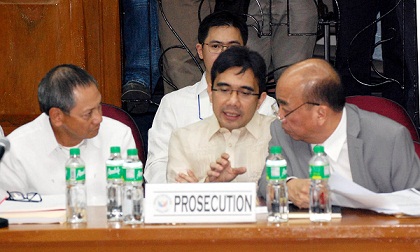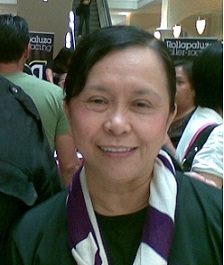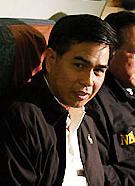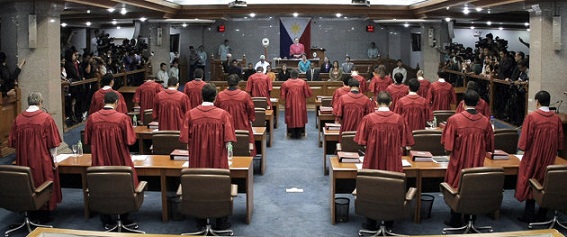 The prosecution’s clumsy preparation of the Articles of Impeachment against Chief Justice Renato Corona has caught up with them.
The prosecution’s clumsy preparation of the Articles of Impeachment against Chief Justice Renato Corona has caught up with them.
Last Wednesday, the impeachment court trying Chief Justice Renato Corona decided to reject the prosecution’s request to present evidence in relation to the alleged ill-gotten wealth of Chief Justice Renato Corona.
Senate President Juan Ponce Enrile, acting as the impeachment court’s president officer, said:”This impeachment court has arrived at a decision in that caucus that this court will allow the introduction of evidence and impeachment on article 2 paragraph 2.2 and 2.3 but not the introduction of evidence of paragraph 2.4. And so parties must be guided accordingly,” Enrile said.
Paragraph 2.4 states: “Respondent is likewise suspected and accused of having accumulated ill-gotten wealth, acquiring assets of high values and keeping bank accounts with huge deposits.”
Article of Impeachment No. 2 deals with Corona’s non-disclosure of his statement of assets liabilities and net worth.
The impeachment court allowed the presentation of evidence related to paragraph 2.2 of Article 2, dealing with Corona’s failure to publicly disclose his SALN, and paragraph 2.3, regarding the allegation he did not declare a number of his alleged properties in his SALN.
Senator Francis Escudero has pointed out what was wrong with the jumbled issues raised by Article 2.
The prosecution, as expected, was dismayed. That means that all those evidence they claim to have gathered to prove that Corona has ill-gotten wealth would just be presented in press conferences, as they have been doing the past week.
Prosecution Panel spokesman Marikina City Rep. Miro Quimbo said based on what they have presented in the impeachment court, Corona has amassed wealth of at least P10 million which reported income from 2006 to 2010 could not support.
“There is a variance of P10 million. This means that there is an unexplained increase in Corona’s wealth based on what he reported in his SALN, which is also not supported by his salary and that of his wife,” he said in a press conference.
Wait a minute. Quimbo used the world “unexplained”. Have they abandoned, “ill-gotten”?
SaxnViolins, who has patiently illuminated visitors in my blog on the legal intricacies in the impeachment trial has this to say:
“What a difference a phrase makes.“
“What is the difference between “unexplained wealth” and “ill-gotten wealth”? A lot, if you read RA 3019 and RA 7080.
“RA 3019 is the Anti-Graft and Corrupt Practices Act while RA 7080 is An Act Defining and Penalizing Plunder.
“Unexplained wealth is defined as:
Section 8. Dismissal due to unexplained wealth. If in accordance with the provisions of Republic Act Numbered One thousand three hundred seventy-nine, a public official has been found to have acquired during his incumbency, whether in his name or in the name of other persons, an amount of property and/or money manifestly out of proportion to his salary and to his other lawful income, that fact shall be a ground for dismissal or removal. Properties in the name of the spouse and unmarried children of such public official may be taken into consideration, when their acquisition through legitimate means cannot be satisfactorily shown. Bank deposits shall be taken into consideration in the enforcement of this section, notwithstanding any provision of law to the contrary.
“So unexplained wealth, as stated in the above-cited case of Simplicio Berdon, enjoys a legal presumption. The burden shifts to the Defendant, to prove that he acquired the property legally.
“But “ill-gotten wealth” is defined as follows:
Section 1 d) Ill-gotten wealth means any asset, property, business enterprise or material possession of any person within the purview of Section Two (2) hereof, acquired by him directly or indirectly through dummies, nominees, agents, subordinates and/or business associates by any combination or series of the following means or similar schemes:
1) Through misappropriation, conversion, misuse, or malversation of public funds or raids on the public treasury;
2) By receiving, directly or indirectly, any commission, gift, share, percentage, kickbacks or any other form of pecuniary benefit from any person and/or entity in connection with any government contract or project or by reason of the office or position of the public officer concerned;
3) By the illegal or fraudulent conveyance or disposition of assets belonging to the National Government or any of its subdivisions, agencies or instrumentalities or government-owned or -controlled corporations and their subsidiaries;
4) By obtaining, receiving or accepting directly or indirectly any shares of stock, equity or any other form of interest or participation including promise of future employment in any business enterprise or undertaking;
5) By establishing agricultural, industrial or commercial monopolies or other combinations and/or implementation of decrees and orders intended to benefit particular persons or special interests; or
6) By taking undue advantage of official position, authority, relationship, connection or influence to unjustly enrich himself or themselves at the expense and to the damage and prejudice of the Filipino people and the Republic of the Philippines.
“There is no presumption here. By definition, “ill-gotten wealth” is by the means with which it has been acquired, such as:
1) Misappropriating public funds
2) Receiving a commission or kickback
3) Illegal or fraudulent conversion of assets belonging to the National government,etc.
“The prosecution has to prove that property was acquired by the means stated in the definition.
“Article 2.4 of the Articles of Impeachment states:
“ 2.4. Respondent is likewise suspected and accused of having accumulated ill-gotten wealth, acquiring assets of high values and keeping bank accounts with huge deposits. “
SNV further said, “Diyos ko po. Pinahirapan mo naman ang sarili mo Niel Tupas. Had you stated “accumulating unexplained wealth” home free ka na. But now, you need evidence to prove the means of acquisition stated in RA 7080.”



